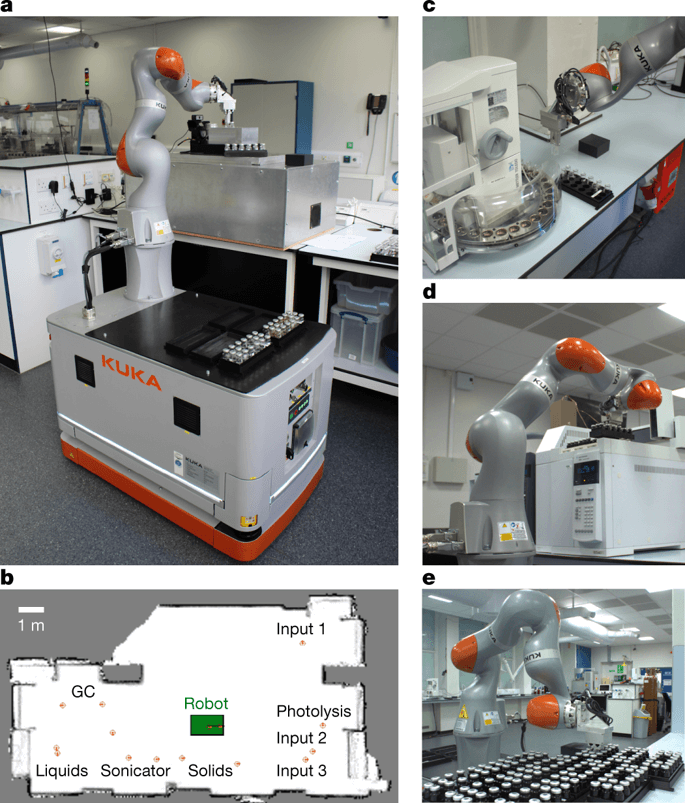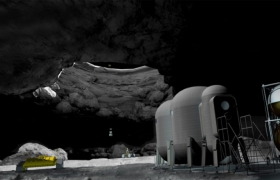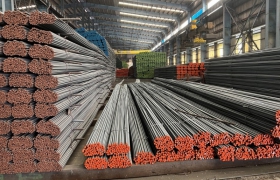- Luật
- Hỏi đáp
- Văn bản pháp luật
- Luật Giao Thông Đường Bộ
- Luật Hôn Nhân gia đình
- Luật Hành Chính,khiếu nại tố cáo
- Luật xây dựng
- Luật đất đai,bất động sản
- Luật lao động
- Luật kinh doanh đầu tư
- Luật thương mại
- Luật thuế
- Luật thi hành án
- Luật tố tụng dân sự
- Luật dân sự
- Luật thừa kế
- Luật hình sự
- Văn bản toà án Nghị quyết,án lệ
- Luật chứng khoán
- Video
- NGHIÊN CỨU PHÁP LUẬT
- ĐẦU TƯ CHỨNG KHOÁN
- BIẾN ĐỔI KHÍ HẬU
- Bình luận khoa học hình sự
- Dịch vụ pháp lý
- Tin tức và sự kiện
- Thư giãn

TIN TỨC
fanpage
Thống kê truy cập
- Online: 223
- Hôm nay: 198
- Tháng: 1621
- Tổng truy cập: 5245625
Robot scientist discovers a new catalyst
Researchers at the University of Liverpool have built an intelligent, mobile, robotic scientist that can solve a range of research problems.
The robot seen here can work almost 24-7, carrying out experiments by itself. The automated scientist – the first of its kind – can make its own decisions about which chemistry experiments to perform next, and has already discovered a new catalyst.
With humanoid dimensions, and working in a standard laboratory, it uses instruments much like a human does. Unlike a real person, however, this 400 kg robot has infinite patience, and works for 21.5 hours each day, pausing only to recharge its battery.
This new technology – reported in the journal Nature and featured on the front cover – is designed to tackle problems of a scale and complexity that are currently beyond our grasp. New drug formulations could be autonomously discovered, for example, by searching vast and unexplored chemical spaces.
Robots have been used in chemistry research previously, but are typically hardwired to a specific experiment. By contrast, this 1.75m (5' 9") tall robot is mobile and can roam freely around a laboratory, performing a wide range of different tasks.
The machine can work with equipment designed for human operation because of its human-like dimensions and physical reach. It uses a combination of laser scanning coupled with touch feedback for positioning, rather than a vision system.

In the first published example, the robot conducted 688 experiments over eight days, working for 172 out of 192 hours. To do this required 319 moves over a total distance of 2.17 km (1.35 miles) and the completion of 6,500 manipulations.
All tasks in the experiment – such as weighing out solids, dispensing of liquids, removing air from the vessel, running the catalytic reaction, and quantifying the reaction products – were performed by the robot independently.
According to its designers, the robot's brain uses a search algorithm to navigate a "10-dimensional space" of 98 million candidate experiments, deciding the best experiment to do next based on the outcomes of previous ones. In this way, it autonomously discovered a catalyst that is six times more active, without the need for additional guidance from the research team.
"The biggest challenge was to make the system robust. To work autonomously over multiple days, making thousands of delicate manipulations, the failure rate for each task needs to be very low," explains Dr Benjamin Burger, PhD, who built and programmed the robot. "But once this is done, the robot makes far fewer mistakes than a human operator."
"Our strategy here was to automate the researcher, rather than the instruments," said Professor Andrew Cooper from the University's Department of Chemistry and Director of the Materials Innovation Factory in Liverpool, who led the project. "This creates a level of flexibility that will change both the way we work and the problems we can tackle. This is not just another machine in the lab: it's a new, superpowered team member – and it frees up time for the human researchers to think creatively."
By Futuretimeline.net
Các bài viết khác
- Từ sự kiện Tổng biên tập báo TIME Greta Thunberg là Nhân vật của năm 2019 đến báo cáo Biến đổi khí hậu Phúc trình của IPCC báo động đỏ cho nhân loại 82021 (15.01.2020)
- Dị tượng liên tiếp: Hồ Bắc xuất hiện vòi rồng, Thượng Hải trời đột nhiên tối sầm (30.06.2020)
- Vị trí thống trị tài chính thế giới của Mỹ đang bị đe dọa (30.06.2020)
- Chính sách phát triển nhà ở trong vòng 10 năm tới của TP HCM sẽ thay đổi ra sao? (30.06.2020)
- Thị trường cà phê trung và thấp cấp TP. HCM sẽ khốc liệt đến mức nào sau khi 3 đại bàng Vinamilk, Nestle và Nutifood xuống núi? (30.06.2020)


















































 Yahoo:
Yahoo: 